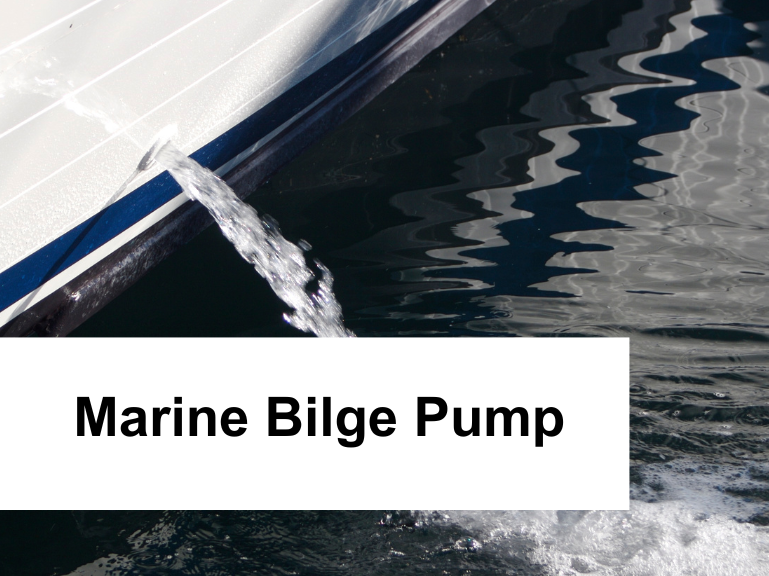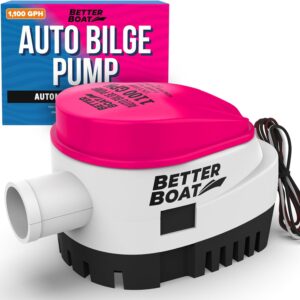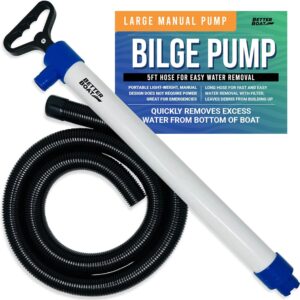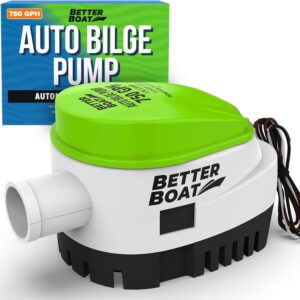Best Marine Bilge Pump Selection Guide 2024

Finding the right marine bilge pump for your vessel can be as crucial as setting the sails for a smooth sea journey. Whether you own a small skiff or a grand yacht, reliable bilge pumps are at the heart of a safe maritime experience. With options ranging from a compact 12v bilge pump to a robust automatic bilge pump, understanding the nuances of each type—be it submersible, electric, or portable—is paramount. As you embark on selecting the most suitable bilge pump for your boat, several factors will guide your choice, ensuring you find a bilge pump for boats that is as dependable as it is durable.
Our Picks For The Best Marine Bilge Pumps
Auto Bilge Pump 1100 GPH Boat Bilge Pump
This is another popular option with a high flow rate of 1100 gallons per hour. It also has a built-in float switch and is corrosion-resistant. It is a good choice for smaller boats or boats that don’t need a high flow rate.
Manual Bilge Pump for Boats Kayak Canoe Hand Water Pump
Its no-clog filter and watertight gasket demonstrate an unparalleled commitment to quality, ensuring a leak-free operation and prevention of debris blockage. This feature alone sets it apart from competitors, reinforcing its superiority. Lightweight and portable, it stands as an essential tool for emergencies, embodying the ideal balance between functionality and convenience.
Crafted from premium materials, this marine-grade bilge pump promises durability and reliability, season after season. The brand behind it, a family-owned American business, guarantees satisfaction with their commitment to quality in both product and customer service.
Pros:
- 60″ long hose for easy reach
- 1 gallon of water removed with 1 to 2 pumps
- No-clog filter and watertight gasket
- Lightweight and portable
- Made from premium, marine-grade materials
Cons:
- Limited to manual operation, might not suit all emergency situations
SeaSense 800 GPH AUTOMATIC BILGE PUMP
This 800 GPH fully automatic bilge pump is an excellent choice for any boater who wants a reliable and efficient way to keep their bilge dry. The high flow rate, built-in float switch, and durable construction make it a smart investment for ensuring the safety of your vessel. The ignition protection and certified flow rate add to its reliability, while the long wire leads, stainless steel components, and quick-release strainer base enhance its user-friendliness and maintenance. The universal mounting holes further expand its versatility, making it a fit for various boats. While it’s manufactured in China, the product’s quality and performance are up to par with high-end bilge pumps.
If you’re looking for a reliable, easy-to-use, and efficient bilge pump that can handle even the most demanding conditions, this 800 GPH fully automatic bilge pump is a great option. It’s sure to keep your bilge dry and your boat safe, allowing you to enjoy worry-free boating adventures.tunesharemore_vertadd_photo_alternate
MAXZONE Automatic Submersible Boat Bilge Water Pump 12v 1100gph Auto with Float Switch
This automatic bilge pump with built-in float switch has a flow rate of 1100 gallons per hour and is powered by a 12V 8A adapter. It has a 1.14-inch outlet diameter and is fully automatic, meaning it will only turn on when water levels rise. It is also equipped with an electronic controlled reed sensor system for reliable operation.
Automatic Bilge Pumps for Boats Auto Bilge Pump 750 GPH Boat Bilge Pump with Float Switch Built In 12V Bass Boat, Jon Boat and More Small Submersible Pump with 3/4 in Output
Ensure your boat remains watertight with this automatic bilge pump that swiftly removes unwanted water, keeping your vessel safe and dry. The auto float switch activates automatically when water levels rise, prompting the pump to operate at a remarkable rate of 750 gallons per hour, effectively eliminating water from your boat. Powered by 12V 3.0 AMP, this versatile bilge pump is ideal for various small watercraft, including bass boats and jon boats. Its compact design, measuring 5.5″ x 3.5″ x 4″ H, and grated base prevent clogging, ensuring optimal performance. Experience the peace of mind that comes with a 5-year warranty backed by Better Boat, a family-owned American business dedicated to providing premium quality boat accessories and marine solutions.
Understanding the Basics of Marine Bilge Pumps
At the heart of your vessel’s safety system lies the essential boat bilge pump, a device engineered to evacuate unwanted water from the bilge, countering potential flooding that could compromise buoyancy and safety. Recognizable types of bilge pumps, notably marine pumps, fulfill distinct roles aboard your boat, adapting to various circumstances that you may face while navigating waters.
In cases where power is inaccessible, a manual bilge pump becomes indispensable due to its non-reliance on your boat’s electrical systems. This manual counterpart requires physical operation, offering reliability during outages or electrical failures. However, for boaters seeking convenience and assurance, especially when away from their vessel, the automatic bilge pump presents an invaluable advantage. Outfitted with integrated sensors, these pumps activate autonomously upon sensing water, maintaining dryness within the bilge.
Automatic marine pumps are the sentinel of your ship, standing vigilant against ingress water, ensuring your continued voyage.
As you consider portable bilge pumps for emergency or temporary applications, recognize that each variant employs a diaphragmatic mechanism—a sequential dance of suction and pressure. This movement delicately draws in the bilgewater and subsequently expels it, maintaining the sanctity of your craft’s internal environment.
Installation procedures diverge between the electric-powered and hand-operated pumps; electrical bilge pumps tout ease, readily integrating into your boat’s existing system, while manual pumps seek strategic positioning for optimal efficacy—demanding a hands-on, contemplative installation approach.
- Manual pumps: revered for reliability during power-less predicaments
- Automatic pumps: a beacon of convenience, activating without your presence
- Electric pumps: boasting a seamless meld with your boat’s power grid
- Portable pumps: ready-to-deploy protectors for versatile, immediate use
Whether it’s the silent standby of an automatic pump or the stalwart dependability of a manual apparatus, the boat bilge pump remains a non-negotiable guardian of your maritime journey. The diverse selection ensures that no matter the specifics of your nautical adventure, you have a tailored sentinel ready to preserve the integrity of your seafaring sanctuary.
Marine Bilge Pump Features for Optimal Safety and Performance
Equipping your boat with the right bilge pump is paramount for safety and efficient water management. Various factors, including capacity, automation, and construction, play into how effectively your pump operates in demanding marine environments. Let’s dive into what makes for an optimal bilge pump setup based on these essential features.
You can read more about Boating Regulations: Safety Standards in this blog
Importance of Bilge Pump Capacity for Different Boat Sizes
The capacity of your marine bilge pump should align with your vessel’s size to ensure adequate water removal. Smaller boats under 20 feet necessitate pumps capable of at least 1,000 GPH. As boat size increases, so does the need for greater capacity; vessels from 20 to 25 feet require upwards of 2,500 GPH. Remember that real-world conditions may significantly decrease a pump’s advertised capacity—a critical factor to consider when selecting your 12v bilge pump or submersible bilge pump. These recommended capacities establish a benchmark, but you should account for actual performance, which can be impacted by factors like hose diameter and elevation.
How Automatic Operation Enhances Pump Efficiency
Integrating an automatic bilge pump in your boat’s water management system provides a seamless and efficient way to handle water intrusion. With sensors to detect water levels, these pumps offer hands-off operation, kicking into gear when you need them the most. This is particularly beneficial for times when your boat is docked or during rough weather. To closely monitor your automatic system’s activity, consider auxiliary features such as bilge counters or indicators for an extra measure of security.
Assessing the Durability and Construction of Bilge Pumps
Durability is a crucial aspect when it comes to selecting a bilge pump for boats. A reliable marine pump should be constructed to withstand marine conditions, which means prioritizing features like long, tinned leads and waterproof connections for submersible bilge pumps. Manufacturers’ warranty periods can be a strong indicator of pump and switch dependability. Emphasis should also be placed on choosing robust switch types that minimize the risk of accidental engagement, ensuring your system’s reliability over the long term.
Selecting the Right Marine Bilge Pump for Your Vessel
Embarking on the journey to find the perfect bilge pump isn’t just about making a purchase—it’s about investing in the safety and longevity of your beloved vessel. As you navigate the waters of choices, it’s critical to match the bilge pump’s capacity to your boat’s requirements. The portable bilge pump, for example, may be ideal for small vessels and emergency situations with its ease of use and capacity for immediate water removal.
On the other hand, larger vessels might benefit more from a submersible bilge pump, offering enhanced durability and power that’s necessary for the increased demands of bigger watercraft. In the table below, we’ve outlined some considerations to keep in mind:
| Criteria | Consideration | Benefit |
|---|---|---|
| Boat Size | Ensure compatibility with the recommended GPH | Efficient water removal tailored to vessel size |
| Water Conditions | Account for rough or calm waters | Selected pump handles typical water exposure |
| Storage Capacity | Choose a pump that fits well within your space | Maximize space without compromising performance |
| Redundant Systems | Install an additional pump for added safety | Back-up support in case of primary pump failure |
| Manual vs. Automatic | Consider installing both for versatility | Preparedness for power-dependent situations |
Why stop there, when customization extends beyond the initial criteria? To ensure that your selection of a bilge pump for boats aligns with not just your practical needs but also the rigorous standards of maritime safety, consult with the pump manufacturers. They often offer invaluable insights into the capabilities and limitations of each model. Additionally, consider these factors:
- Automatic Features: For an unattended vessel, automatic pumps offer a level of security that keeps your boat safe, even when you are away.
- Battery Reliability: Check your electrical system’s stability; after all, a great pump requires dependable power to operate effectively.
- Manufacturer Recommendations: Align your choice with their guidelines—these are often anchored in extensive testing and tailored to the nuances of marine environments.
Remember, in the dynamic setting of the open water, a well-chosen bilge pump is your silent sentinel, working tirelessly to keep your vessel afloat and your maritime adventures safe. Make the choice that resonates with your dedication to the craft of boating, and rest assured that you have prepared well for the seas that lie ahead.
Installation Insights for Marine Bilge Pumps
When you’re ready to install a marine bilge pump, accuracy and foresight are key. Proper installation not only secures vessel safety but ensures peak performance of your pump, be it a 12v bilge pump, electric bilge pump, or submersible bilge pump. Let’s delve into the crucial stages of setting up your bilge pump system.
Find out what are Essential Tools to Have in a Boat for Safety & Maintenance
Electrical Considerations: Wiring and Power Supply
To maintain an efficient and safe marine pump system, proper electrical setup is non-negotiable. Verify that the wiring is sufficient to minimize voltage drop, which is especially critical for electric bilge pumps. Should your routing require it, opt for oversized wires to combat potential voltage drops beyond the acceptable 3% benchmark. Direct connections to the battery are a must, and make sure there’s an independent switch to assure continuous operation. Overcurrent protection is also vital – each boat bilge pump must have its own breaker, designed to resist the harsh marine environment.
Plumbing Strategies: Hose Selection and Layout
Efficient water expulsion from your vessel hinges on the right plumbing approach. Choose hoses that resist crushing, with a smooth interior for unrestricted flow, matching the marine pump‘s output specifications. Avoid any constrictions in the hose that could limit the capacity of your portable bilge pump. Short, direct hose runs with wide curves promote better flow and prevent loss of pump power.
Secure Mounting Techniques for Reliable Operation
In the unpredictable marine setting, a securely mounted marine bilge pump is the cornerstone of a reliable bilge system. Position your pump at the lowest section of the bilge to ensure maximum water removal. Marry it with a dependable automatic switch or an alarm for added security, particularly beneficial when the craft is left unattended. For those cruising with manual pumps, permanent onboard installation with versatile intake hoses is advisable to adapt to the changing water levels due to vessel motion. Stability is your ultimate aim, ensuring a consistent, dependable defense against water ingress.
Common Pitfalls to Avoid When Choosing a Marine Bilge Pump
When you’re in the market for a marine bilge pump, you may believe that selecting the highest capacity pump, such as an electric bilge pump, will solve all your water ingress issues. However, there are common pitfalls that can compromise the efficiency and reliability of these crucial devices. The key is to make an informed decision, considering not just the pump’s capacity but also the quality of the installation components and the environment in which it will operate.
One frequent mistake is ignoring the impact of hose material and diameter on the pump’s performance. Using a 12v bilge pump with an incompatible hose can significantly lower its effectiveness. Here’s where many boaters go wrong: they opt for cheaper, corrugated hoses that, while cost-effective initially, may impede water flow and reduce the pump’s capacity. It’s crucial to choose smooth, durable hose materials that align with the pump’s specifications.
Another trap to watch out for is the inclusion of check valves in the installation. While they may seem like a prudent addition, they are prone to failure, especially in salty marine environments, leading to potential flooding. Likewise, the correct installation of float switches cannot be overstated. Especially for an automatic bilge pump, securing float switches properly will ensure they activate when needed, without false triggering due to the boat’s movement or waves.
Lastly, it is fundamental to make all electrical connections waterproof. Bilge areas are wet by nature, and any wiring or connectivity susceptible to water exposure can result in pump failure or even more severe electrical hazards.
Here’s a table comparing recommended hose features for optimal bilge pump performance and some common selections that could lead to underperformance or failures:
| Characteristic | Recommended Choice | Common Poor Choices |
|---|---|---|
| Material | Sturdy, non-collapsible | Cheap, corrugated plastic |
| Diameter | Matches or exceeds pump outlet | Narrow, restricts flow |
| Length | As short as possible | Excessively long, causing drops in pressure |
| Routing | Straight with gradual curves | Sharp bends and loops |
By avoiding these pitfalls, you ensure that your marine bilge pump setup is robust, efficient, and reliable.
Maintenance and Troubleshooting Tips for Your Marine Bilge Pump
For seafarers, a reliable bilge pump system is not just equipment—it’s peace of mind. Proper care equates to prolonged life and performance for your submersible bilge pump or automatic bilge pump. Here’s how you can keep these critical components in shipshape, accompanied by troubleshooting advice for common issues.
Regular Cleaning and Inspection Routines
To maximize the efficiency of your marine bilge pump, it’s essential to keep it clean and inspect it regularly. Even the most durable electric bilge pump or portable bilge pump needs attention. Start by clearing away any obstructive debris and take a moment to examine the electrical connections for corrosion—maintaining them securely waterproof. Regular tests will ensure your 12v bilge pump and its float switch are ready for action, while a careful look at the hoses will keep water flowing smoothly, free from siphoning woes.
Detecting and Addressing Common Issues
Is your boat bilge pump erratically turning on and off, or has its performance dropped inexplicably? These may be signs of a misaligned float switch or an obstruction impeding water flow. Also, keep a keen eye on the electrical system. Voltage drops or finicky indicators point to a need for swift troubleshooting. Manual pump handles should glide freely, and sensors must be attuned to water to function efficaciously.
When to Service or Replace Your Bilge Pump
Recognizing when to service or upgrade your marine pump is crucial. Persistent low performance, abnormal cycling, strange noises, or visible damage signals it might be time to call in the professionals or consider a new bilge pump for boats. Pay close attention to the seal’s integrity and any signs of serious corrosion which could jeopardize the pump’s operation. Following the manufacturer’s service guidelines helps in pre-empting issues, so treat your marine pump’s maintenance as a priority for a seamless voyage experience.
Conclusion
In the pursuit of maritime security and boat longevity, the role of the marine pump is indispensable. Your vessel’s safeguarding from water-related hazards is contingent on a marine bilge pump system that aligns with the distinct parameters of your boat. This includes the size of your vessel and the unique environmental challenges it faces. When selecting the most suitable boat bilge pump, it’s essential to consider not just the advertised capabilities, but the actual performance you can expect in the conditions you typically encounter.
Installation of an electric bilge pump demands attention to detail and adherence to stringent maritime safety protocols. By engaging in rigorous installation practices—including correct wiring, strategic hose placement, and secure mounting—you ensure functional resilience and efficiency. Bear in mind that the efficacy of your bilge pump goes hand in hand with your commitment to regular maintenance. By proactively inspecting, cleaning, and attending to any signs of operational decline, you can anticipate and circumvent issues before they escalate into critical failures.
Your vessel’s bilge pump is more than just a piece of equipment; it is indeed your silent crew member, continuously working to secure the well-being of your boat and everyone aboard. Through conscious selection, meticulous installation, and dedicated maintenance, you foster an environment of safety and reliability on the water. Remain vigilant and proactive—your marine bilge pump is a critical ally in the enduring health and enjoyment of your seafaring adventures.
Can a Marine Bilge Pump be used in conjunction with a Marine Toilet?
When considering a comprehensive marine toilets buying, it’s important to know that a marine bilge pump can be used in conjunction with a marine toilet. The bilge pump helps to efficiently remove waste from the toilet and keep the system running smoothly.
FAQ
What should I consider when choosing a marine bilge pump?
You should consider the boat size, the specific needs of your vessel, intended use, environmental conditions, and the capacity in gallons per hour (GPH) necessary to ensure your boat’s buoyancy and safety. It’s also recommended to install at least two pumps with one situated higher as a backup. Ensure pumps are directly wired to the battery and follow marine safety standards for electrical and plumbing configurations.
Do I need an automatic bilge pump?
An automatic bilge pump with integrated sensors can offer peace of mind, activating to pump out water as soon as the level rises, which is particularly useful when your boat is unattended. However, the inclusion of a manual pump is also beneficial for situations where you might experience power loss.
How much capacity do I need in a bilge pump for my boat size?
It’s recommended that boats less than 20 feet have a minimum capacity of 1,000 GPH. The capacity should increase incrementally with the size of your boat, up to 8,500 GPH for vessels 37 to 45 feet. Note that actual pumping capacity tends to be approximately 60 percent of the advertised due to real-world conditions affecting performance.
How do I ensure the durability of my marine bilge pump?
Look for bilge pumps with robust construction, corrosion-resistant materials, and long, tinned leads for electrical connections. Pumps should be submersible with waterproof connections. A warranty period can be a good indicator of a pump’s reliability, with a five-year coverage being optimal.
What is important for the correct electrical installation of a marine bilge pump?
It is essential to use appropriately sized wiring to minimize voltage drop, directly connect the circuit to the battery, install an independent switch, and utilize a durable circuit breaker for each pump. Pay attention to the manufacturer’s recommendations for correct fuse ratings to prevent electrical fire hazards.
What hose should I use for my bilge pump plumbing?
Use crush-resistant hoses with a smooth interior that matches or exceeds the pump outlet size. Avoid corrugated hoses as they can impede water flow. Strive for short, straight plumbing runs and use sweep fittings rather than sharp angles to maintain efficiency.
How do I avoid common pitfalls when choosing a bilge pump?
Avoid overreliance on marketing capacities, using unsuitable or cheap hose materials, and installing check valves that are prone to failure, especially in saltwater. Proper installation of float switches and ensuring all electrical connections are watertight are also crucial steps to avoid common issues.
What maintenance should I perform on my marine bilge pump?
Implement regular cleaning to remove any debris and inspect for blockages. Check electrical connections for signs of corrosion, test automatic switches and alarms for functionality, and ensure that hoses are in good condition and correctly routed. Address any irregularities immediately to maintain pump performance.
How do I know when to service or replace my bilge pump?
Indicators such as consistent underperformance, frequent automatic cycling, abnormal noises, or visible damage are signs that your pump may need servicing or replacement. If your pump repeatedly blows fuses or you observe significant corrosion, consult a professional for an assessment or consider upgrading to a newer model.





